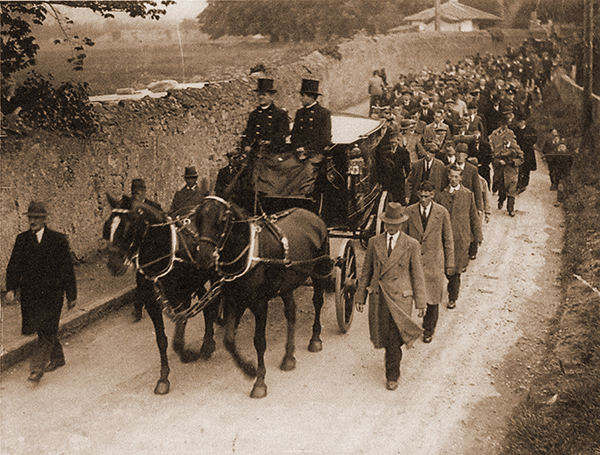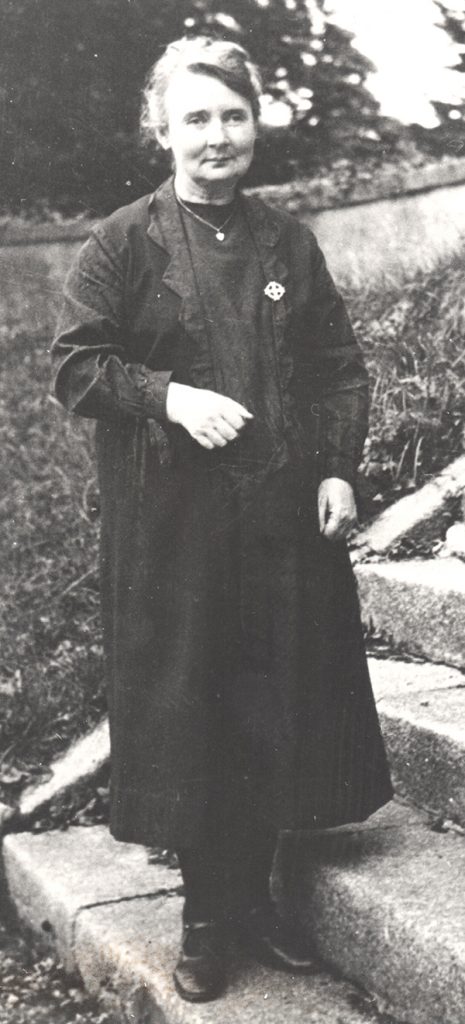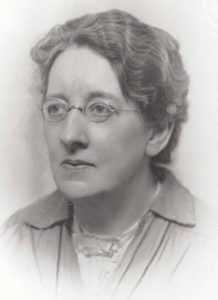Loss and litigation
Published in 20th-century / Contemporary History, Features, Issue 5 (September/October 2016), Volume 24THE SCANDAL OF MARGARET AND MARY BRIGID PEARSE
By Teresa and Mary Louise O’Donnell
Margaret Pearse, mother of Patrick and Willie, died on 22 April 1932 from a bacterial infection of the skin. She was survived by her daughters Margaret Jr (1878–1968), a teacher and language activist, and Mary Brigid (1884–1947), a musician and author. Tributes in various newspapers invariably commented on Mrs Pearse’s gentle character and stoicism. A journalist from the Irish Independent wrote:
‘Few mothers have been called upon to make such a sacrifice for their country, and no one could have made it more uncomplainingly . . . she was a quiet, gentle lady with kindly, gracious manners, distinguished by her mass of beautiful white hair, fine features, and the complexion of a young girl. She was the worthy mother of such illustrious sons.’

Above: The funeral cortège of Mrs Margaret Pearse, mother of the Pearse brothers, passing along the exterior wall of St Enda’s, Rathfarnham, in April 1932. (South Dublin Libraries)
Mrs Pearse’s will

Above: Margaret Pearse Jr—along with her mother, prior to the latter’s death in 1932, she had shouldered the financial burden of running St Enda’s. (Pearse Museum)
According to Mrs Pearse’s will, which was made on 20 April, just days before her death, her daughter Margaret was appointed sole executrix. Mrs Pearse’s estate was valued at £1,586. St Enda’s School in Rathfarnham was left to Margaret for the duration of her life and, on her death, it was to be gifted to the Irish State and kept as a memorial to Patrick and Willie. Mrs Pearse specified that St Enda’s and its grounds were not to be used as a school or institution and that its furniture was to remain there until Margaret’s death. Cullenswood House, Ranelagh (the original location of St Enda’s School), was bequeathed jointly to Margaret and Mary Brigid and, after their deaths, the proceeds of the sale of the property were to be used to fund Masses for Mrs Pearse and deceased members of her family. Another property owned by the Pearse family, 20 Ashfield Park, Terenure, where Mary Brigid resided, was left to her. Mrs Pearse left her shares in the Irish Press to Margaret. She also bequeathed money, in equal share, to the Carmelite Fathers of Whitefriar Street, the Jesuit Fathers of Rathfarnham and the Passionist Fathers of Mount Argus, Dublin.
Soon after Mrs Pearse’s will was read, Mary Brigid sought legal advice. She was unhappy with the terms of the will and with the appointment of Margaret as executrix. Mary Brigid and Margaret’s relationship had been fractious since their childhood, and Patrick often acted as peacemaker between the two sisters, as did their mother. Prior to 1933, Mary Brigid expressed no interest in her family’s financial situation. Her family had always provided for her and she had no financial concerns. When Patrick died, his debts passed to his mother and then to Margaret. Mary Brigid was never liable for any of these debts, as the entire financial burden was shouldered by Margaret and her mother, who often struggled to meet the expenses of running St Enda’s. Following the publication of the will, Mary Brigid engaged the services of Meldon Solicitors, 9 Bachelor’s Walk, Dublin, in June 1933 to advise on her entitlements. Through her solicitors, Mary Brigid demanded that Margaret’s solicitor, Daniel C. Maher, 20 Westland Row, provide a valuation of each of the properties at St Enda’s, Cullenswood House and 20 Ashfield Park and a detailed statement of their mother’s stocks and shares. In February 1934 Mary Brigid dismissed her solicitors and engaged the services of another solicitor and friend, Bernard Bernstein. He wrote to Margaret’s solicitor requesting a statement of the royalties from Patrick’s literary works, details of Patrick’s cottage in Rosmuc and a statement of the rents collected from, and outgoings of, the various properties since their mother’s death. On 19 April 1934 Bernstein informed Margaret, through her solicitor, that Mary Brigid wanted all legal and financial matters to be resolved immediately so that she could be disassociated from her.

Above: Mary Brigid Pearse—in May 1936 she discharged her senior and junior counsels and her solicitor, Bernard Bernstein; subsequently she had no further contact with him or with her sister. (Pearse Museum)
Margaret was dilatory in providing Bernstein with a detailed statement of the rents collected from the various properties, as she did not want Mary Brigid interfering with the collection of rental income. Mary Brigid became increasingly frustrated with Margaret and believed that her sister was misappropriating her inheritance. She demanded the deeds to 20 Ashfield Park, the house bequeathed to her, and insisted that Margaret purchase her half-share in Cullenswood House. As Cullenswood was already mortgaged this was not feasible. In late April 1934 Mary Brigid expressed a desire to her solicitor to instigate legal proceedings against her sister, but Bernstein warned against this. Given these threats of legal action, Margaret approached Éamon de Valera, who suggested that the dispute might be resolved through arbitration, but this option was not pursued.
The home life of Pádraig Pearse
Relations between the sisters further deteriorated with the publication of Mary Brigid’s book The home life of Pádraig Pearse in late 1934. Margaret and her mother had supported Mary Brigid’s literary project by contributing written accounts of Patrick, and the resulting publication should have been an important celebration in the lives of the Pearse family. Unfortunately it was not. Mary Brigid’s narrative of the family’s idyllic childhood was a stark contrast to the acrimonious dispute between the sisters in adulthood; it was also a reminder of the importance of Patrick and, later, his mother as unifying figures in the Pearse family.
As sections of Patrick’s unfinished autobiography were incorporated into the book, both Margaret and Mary Brigid were entitled to royalties from the publication. Margaret wrote to Mary Brigid’s publisher, Browne and Nolan, to inform them that she had not consented to the publication and was due a share of the royalties. Mary Brigid disputed Margaret’s claim and the latter relinquished any rights to royalties from the book. Mary Brigid resented her sister’s actions and immediately contacted the publisher to cancel the print run. Browne and Nolan, having invested £138.19.6 and printed 500 copies, were reluctant to agree to her demands. Nonetheless, Mary Brigid insisted that she would prefer to repay personally the amount of their investment to date rather than have any doubt about the ownership of the manuscript. All books were subsequently withdrawn and Mary Brigid purchased all unsold copies. Later, with the help of Kathleen Cruise O’Brien, Mary Brigid approached Eason & Sons with a view to selling the remainder of her stock. Easons agreed to sell the book on condition that she would provide a written guarantee that all issues had been satisfactorily resolved with her sister.
Dispute over Patrick’s royalties
The publication of the book was not the only contentious issue between Margaret and Mary Brigid. Royalties from Patrick’s literary works were divided in the ratio of two thirds to Margaret and one third to Mary Brigid. These royalties were paid directly to Margaret by publishers such as the Educational Company, Talbot Press and Folens and she subsequently paid Mary Brigid. The irregularity of the payments irked Mary Brigid; she contacted each of the publishers to request that her share of the royalties should be paid directly to her and this request was eventually acceded to.
By the end of 1935, Mary Brigid’s main grievances over income from and ownership of the family’s properties, the royalties from Patrick’s literary works and The home life had been resolved. She was still not satisfied, however, and, despite the advice of her counsel, wanted to pursue a case against her sister through the courts. Her relationship with her solicitor, Bernard Bernstein, became increasingly strained in this period. In a letter dated 12 November 1935 he wrote:
‘I want you to be so careful about your case that everything I do for you should be straight, honest and above board. You should not blame counsel. You and they simply cannot see eye to eye. That is all there is to it. I have been a good friend to you from the day I undertook your affairs. If you want me to retire from the case then I will do so. I have done everything possible for you both as your lawyer and as your friend but I do not appear to be appreciated.’
Mary Brigid’s erratic behaviour and her unwillingness to accept the advice of her legal counsel embarrassed and irritated Bernstein. He informed her:
‘Your case is not worrying me. It is yourself who worries me. Why could you not leave me alone and stop harrying me? If you do not want me to go on with your case then I will do so. But I will say this—so far as counsel and I are concerned we have done our utmost to get you to settle on terms which to us cover and protect your interests amply, and if you want to throw away your money on costs then you can do so.’
In May 1936 Mary Brigid discharged her senior and junior counsels. Shortly afterwards, she settled her bill of c. £140 with Bernstein and had no further contact with him or with her sister.
Teresa and Mary Louise O’Donnell are the authors of Sisters of the revolutionaries: the story of Margaret and Mary Brigid Pearse (Merrion Press, 2017).
FURTHER READING
M. Pearse, ‘Patrick and Willie Pearse’, Capuchin Annual (1934), 86–8.
M. Pearse, ‘St Enda’s’, Capuchin Annual (1942), 227–30.
M.B. Pearse, The home life of Pádraig Pearse (Dublin, 1934).
















